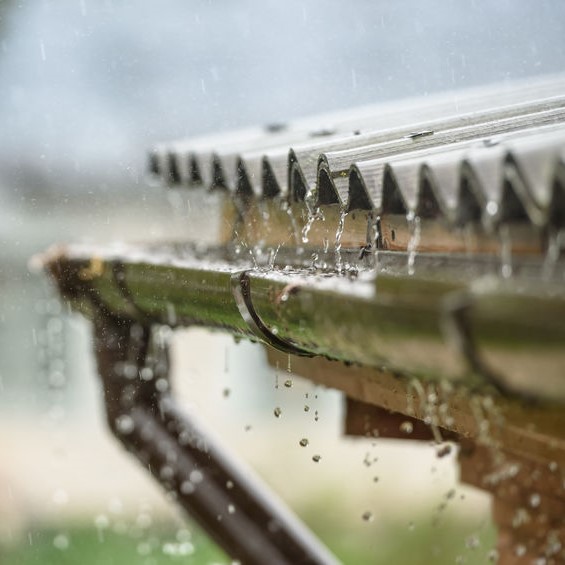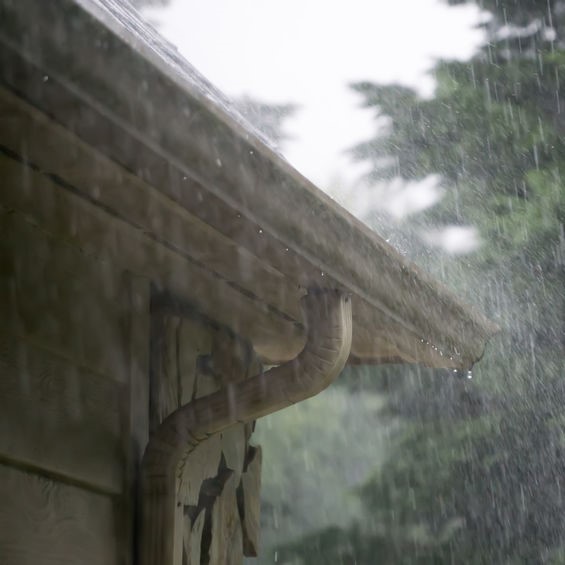
Preventing roof water damage
The roof of your house is the protector of your house, the contents, and your family, and so is the roof drainage system you have installed. What is a roof drainage system? The roof drainage and components assist the roof in protecting your home from the elements.
The roof drainage system is made up of various components, two of the main ones are the gutter system and the downspout, and some parts and pieces put those together and fasten them to your house. The roof of your home is stable and robust and roof drainage and components, when professionally installed, will redirect any debris and moisture that has been left on the roof, down through roof drainage to the ground and away you’re your foundation.
Why is roof drainage so crucial to your home and the roof? When moisture is allowed to sit in a room, it will seem under the asphalt shingles and begin to mildew, and mold growth will form. Mold is a live organism that will eat through the asphalt shingles, the underlayment, and decking. After a while, you’ll have a roof leak.
Where do roof drains go?
Which roof drainage application to use on your roof depends on a few factors, like the roof size and slope, the appearance desired, and the level of maintenance you desire. To determine the number of drains needed for your roof, divide the roof drainage area for each leader.
Each leader should be big enough to handle the water drainage volume. The bigger the capacity, the fewer drains needed. The spacing should be equal and located in the roof’s low points or where water accumulates.
Conventional Gutter Roof Drainage
This roof drainage is what most homes have, suitable for roofs with a two percent or greater slope. This roof drainage system is inexpensive and simple but will require regular cleaning, keeping even the smallest debris from causing a gutter system to overflow. The conventional gutter system is installed along the roof’s bottom edge and is fully visible. Downspouts are mounted on the side walls of the house.
Scupper Roof Drainage
Scuppers are a method of roof drainage that is commonly on flat roofs with a bulwark or other perimeter barrier that encloses the roof. Scuppers are channels or open holes cut into the bulwark or roof edge. All flat roofs have some slight slope, and flat roofs with scuppers, the water drains through the scuppers, sometimes into a downspout or an extended chute that directs the water stream away from the building.
Inner Roof Drainage
Inner roof drainage that is used typically on flat roofs includes a low channel that accumulates water then feeds it into a drain that is concealed and goes into underground drainage. This roof drainage system is not visible and is freeze-resistant, both significant benefits. However, inner roof drainage requires routine maintenance for prevention purposes.
How can I improve my gutter drainage?
Inadequate roof drainage will put your home at risk with severe water damage. From the roof, attic, ceiling, walls, and especially the basement, which will weaken the foundation. A sump pump is an additional measurement, but without the proper roof drainage system that diverts water away from your home, you’re putting your home at risk.
So, if your gutter roof drainage isn’t working correctly, here are ten things that roof drainage experts suggest that can improve your home’s roof drainage and runoff:
- Inspect and Clean Gutters Regularly: Experts recommend cleaning gutters twice a year: fall and spring. While cleaning them, inspect them for any broken or missing components and make repairs as needed.
- Gutter Guards: Gutter guards professionally installed will prevent clogs from forming and causing the roof drainage to overflow or back up under the shingles.
- Landscape and Plants: Create a natural solution for roof drainage problems with a rain garden that can manage the water runoff.
- Lengthen Downspouts: There is a retractable downspout you can add to the existing downspouts that will help with the roof drainage and keep the water flowing.
- Dry Well or Storm Drain: Have a plumber provide you a quote for a Sump Pump installation to direct water away from your home’s foundation and into a nearby storm drain.
- Grading and Slope: To do this, you’ll need to hire a professional excavation, making this an expensive option, but it will allow water to flow past your home as it comes off the roof drainage system.
- Fill In Low Spots: If you notice there are low spots around your home, have dirt hauled to fill them.
- A French Drain: A French drain consists of a trench filled with gravel or sand that allows water to flow out of the roof drainage system and away from your home.
- Impermeable Surfaces: Impermeable surfaces can cause water not to flow away. An expensive option, but if you change the existing concrete into permeable pavers, it will dramatically help.
- Rainwater Collection: Purchase cisterns, rain barrels and build the aforementioned rain garden to help with roof drainage problems.
Why do my gutters overflow in heavy rain?
Gutters overflowing is caused by one of two things: The gutters are clogged, or the gutters are broken. These are the reasons you need to either clean and inspect your gutter regularly or have it done by a professional.

Should you bury your downspouts?
You can, but you want to make sure you dig the trench deep enough but not too deep and to extend it far enough out so that the water is directed to a safe area. The trench should be no less than six inches wide and have a 1 to 2-inch slight slope, so the water drains away from the downspouts. Be sure to bury the pipe below the frost line if you’re in the snow belt, typically thirty-two to forty-eight inches.
If you’re a DIY homeowner, you may be tempted to do your roof drainage system yourself. Keep in mind that the roof drainage system is protecting a valuable investment for you. It may be worth the expense to have it professionally installed. For quality installation, call 770-735-4433 today!

